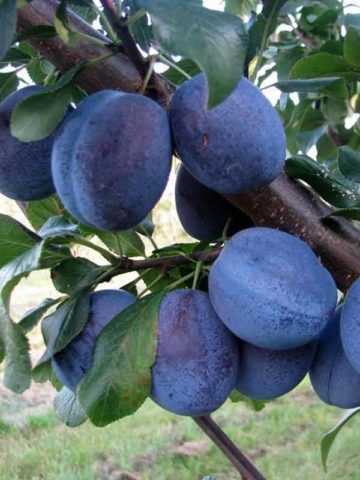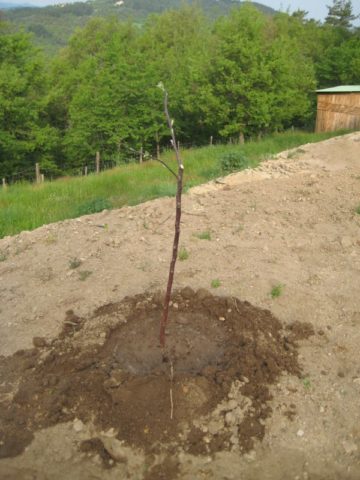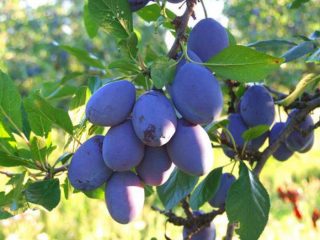Content
The plum "Black Tulskaya" is a late-ripening variety. Its popularity among gardeners is explained by its tasty juicy fruits, excellent yield, and resistance to many diseases.
History of variety selection
How this black plum appeared is not known exactly. According to some gardeners, this is a seedling that grew after accidental pollination of a tree of the Hungarian domestic variety.
The first description of the black plum was made by agronomist G. Ya. Serebro in the last century.
Description of the plum variety Black Tula
The variety has several other names:
- Tula prunes;
- Winter blue;
- Meshchovsky prunes;
- Bryansk late.
The tree and fruit have their own special characteristics.
The Tula plum grows up to 4.5 m in height. It has a small, dense, oval crown. The leaves have a dark green tint.
According to the photo of the black plum, the fruit looks like an egg. They cannot boast of large sizes.The weight of the plum reaches a maximum of 30 g. The color of the fruit is dark blue, sometimes with a red tint. There is a bluish coating on the skin.
The pulp of plums is yellow-green, dense, juicy. It tastes sweet. According to tasters, it deserves a rating of 4.1 points out of 5 possible for taste.
Growing the Black Tulskaya plum works best in the Moscow region. The variety is also widespread in the Tula and Kaluga regions.
Characteristics of the variety
The main characteristics of this variety of plum relate to its resistance to adverse weather conditions, fertility, and resistance to certain diseases.
Drought resistance, frost resistance
The Black Tulskaya variety does not tolerate a lack of moisture very well. Due to drought, unripe fruits fall to the ground.
Reviews of the “Tulskaya Chernaya” plum in the Moscow region indicate that its winter hardiness level is average. The tree quickly recovers after a frosty winter.
Pollinators of plum Chernaya Tulskaya
The variety is considered self-fertile. It does not need pollinators for stable fruiting. This is one of its main advantages.
Productivity and fruiting
The “Black Tulskaya” variety produces fruit regularly. Gardeners watched her for 17 years. During this period there was no harvest only 4 times.
The variety's yield level is average. Usually this is about 10 kg of fruit per tree. The maximum value is 35 kg.
Area of application of berries
Black Tula plum is used to prepare various dishes and preparations. This is juice, compote, jam, jam, liqueur. But it is worth remembering that due to the high juiciness of the fruit, preserves and jams turn out to be too liquid.
Resistance to diseases and pests
A pleasant characteristic of the Black Tulskaya plum variety is its resistance to certain types of diseases and pests. The tree is not susceptible to clasterosporiosis and fruit rot.
Advantages and disadvantages of the variety
The Black Tula plum has a number of advantages.
- Stability of fruiting.
- Good yield (maximum 35 kg per tree).
- High taste ratings.
- Easy to separate pulp and pits.
- The tree does not suffer from clasterosporiosis and rot.
Flaws:
- average level of winter hardiness;
- fruit shedding due to lack of moisture;
- influence of weather conditions on taste.
Another significant drawback is the susceptibility to the fatty stem.
Landing Features
How correctly the tree was planted depends on its health and productivity.
Recommended timing
The time for planting seedlings depends greatly on the region. If this is the Moscow region and surrounding areas, it is better to plant in the spring. In a few warm months, seedlings will not only be able to adapt to new conditions, but also prepare for winter.
It is better to start planting 5 days after the snow melts. The entire process takes 2 weeks. If you start it later, during the period of sap flow, the plum will take root poorly.
In regions with mild winters, autumn planting is preferable. We need to get there before the cold weather sets in. The ideal month for planting is October.
Choosing a suitable location
As mentioned above, the taste of the Black Tulskaya plum directly depends on the amount of sunlight. The more sun, the sweeter the fruits will be. That is why seedlings should be planted not in the shade, but in a place open to light.However, they must be protected from the wind. Therefore, the best option is space near the house or fence.
It is better to choose loam from the soil. It is good if groundwater lies at a depth of 1-1.2 m.
It is not recommended to plant plums on heavy, acidic, alkaline or cold soil. Clay will also not work. On it, the root system will be partially located on the surface, which is why it may suffer from severe frosts or air deficiency.
Restrictions are also imposed on sandstones. Such soil has no nutrients at all, and it dries out quickly.
Too low areas are also not suitable for planting the Black Tulskaya plum variety. Cold air accumulates in them. In addition, they are more susceptible to flooding than others.
What crops can and cannot be planted nearby?
It is not recommended to plant the following plants next to the Black Tulskaya tree:
- Walnut;
- hazelnut;
- fir;
- birch;
- poplar.
The proximity of a plum to a pear is also considered unfavorable. However, this applies to cases where the trees are very close to each other.
The Black Tula plum has good or neutral relationships with apple trees and black currants. You can also plant thyme, tulips, daffodils, and primrose near it.
Selection and preparation of planting material
The Black Tula plum seedlings selected for planting must meet several simple requirements.
- Age no more than 2 years.
- The presence of one conductor and three side shoots is a minimum.
- The roots are 35-40 cm long. It is important that the root system does not have growths or overgrowths.
To protect the seedlings during transportation, their roots must be covered with a cloth soaked in water. Wrap the top with polyethylene.
Landing algorithm
Planting of the Black Tula plum is carried out in several stages.
- About 2 weeks before planting, dig up the ground (radius 2 m) and add fertilizers (8 kg of humus, 50 g of superphosphate and 30 g of potassium salt).
- Dig a hole (depth 60 cm, width 70 cm). Combine the earth with peat (2 buckets), superphosphate (300 g) and potassium sulphide (80 g). Pour the mixture into the hole to fill 2/3 of its volume.
- Drive a small peg into the hole.
- Place the “Black Tula” plum seedling in the hole, carefully straighten the roots, and cover with soil. It is important that the root collar is 5-7 cm above the ground.
- Form an earthen roller at a distance of 40 cm from the tree.
- Water the ground with 2 buckets of clean water.
- As soon as the water is absorbed, cover the soil with humus or peat (10 cm).
Several plums of this variety should be planted at a distance of 3 m from each other.
Aftercare for plums
Proper planting and care of the Black Tula plum is the key to a healthy tree and a good harvest. Not a single detail should be overlooked, be it gradual pruning or fertilization.
There are two types of pruning of this type of tree: formative and sanitary. It is held every year.
- After planting, it is necessary to shorten the central trunk of the tree so that it is 25 cm higher than the branches.
- At 2 years of age, the formation of a sparsely layered crown begins. It is recommended to leave the 3 strongest branches. Cut the shoots to 60 cm. It is important that the central trunk still remains 20-25 cm higher than the other branches.
- At 3 years old, the formation of 2 tiers of the crown should begin. It is located 40 cm from the first and consists of 2 branches.
- At 4 years old you need to make the 3rd tier.
- Starting from the 5th year, it is necessary to trim only those branches that make the crown too thick.
Sanitary pruning of plants of this variety is carried out as necessary and does not depend on the age of the plum.It involves removing damaged or diseased branches. It is also recommended to remove root shoots, which have a bad effect on the nutrition and growth of the tree.
As mentioned above, the Black Tula plum variety does not cope well with drought. For this reason, special attention should be paid to watering. During the growing season, you need to water the tree 6 times:
- after the flowers fall;
- 2 weeks after the first watering;
- 2 weeks after the second watering;
- during the period of fruit ripening;
- after the harvest is harvested;
- in September – October.
Feeding is also carried out according to the seasons.
Season | young tree | Tree bearing fruit | Consumption per 1 tree |
May | 2 tbsp. l. urea, 2 tbsp. l. liquid humate and 10 liters of water |
| 20 l |
June | 3 tbsp. l. nitrophoska and 10 liters of water |
| 20 l |
August-early September | 3 tbsp. l. potassium sulfate, 3 tbsp. l superphosphate, 10 l water |
| 20 l |
Early spring |
| 25 g urea, 20 g potassium chloride, 60 g superphosphate |
|
September October |
| 10 kg manure (rotted)/10 kg compost |
|
Another important part of caring for the Black Tula plum variety is its preparation for winter. It starts in October. First of all, the soil around the tree must be cleared of fallen leaves and dug up (20 cm). Afterwards, you need to fill the plum with 70 liters of water and cover it with sawdust or a 10-centimeter layer of peat.
To protect the plant from rodents, the trunk should be whitened. After this, wrap it with a layer of roofing material, glass wool and light-reflecting foil.
Diseases and pests, methods of control and prevention
The plum variety “Chernaya Tulskaya” is not susceptible to clasterosporia and fruit rot. However, it may suffer from other diseases or pests.
Disease | Symptoms | Treatment | Prevention |
Plum pockets | The fruit stretches out and becomes flat.The bone does not appear. Up to 30% of the entire crop is affected. | Treat the wood with a 0.2% copper oxychloride solution. | Destroy infected fruits, thin out the crown, feed the plum with calcium-based fertilizers. |
Gum treatment | Small honey-like drops appear on the trunk. Through the wounds, infection enters the tree. | Clear the trunk of growths. Disinfect the wounds with a 1% solution of copper sulfate and cover them with garden pitch. | Carry out pruning according to schedule. Protect young trees from frost. Regularly check the condition of the tree as a whole. |
Moniliosis | Withering of branches, flowers and leaves. | Before flowering, treat the tree with 3% Bordeaux mixture or copper oxychloride. | Treat plum trees for pests in a timely manner. Burn fallen leaves and branches. |
Dwarfism | A viral disease that affects leaves and peduncles. The first ones change shape, become denser and at the same time fragile. | There is no cure. The diseased plum needs to be dug up and destroyed. | Buy seedlings only from trusted gardeners or nurseries. When working, use only clean tools. Get rid of pests in a timely manner. |
Smallpox | Spots appear on the leaves. Dark dents form on the fruit. | Uproot the tree and burn it. | Preventive measures are the same as in the previous case. |
Of the pests, the plum "Black Tula" is most often affected by the thick stalk, yellow sawfly and codling moth.
- Chlorophos, Karbofos or Mospilan, diluted in water according to the instructions, will help get rid of the fatty leg.
- The same drugs as in the previous case help fight yellow sawfly.
- Chlorophos can protect plums from codling moths. Treatment is usually carried out in mid-June.
The plum "Black Tula" was liked by many gardeners. It has good yield, excellent taste, and resistance to some diseases. Like any other fruit tree, it requires constant care. If everything is done correctly and according to the schedule, the plum will delight you with fruits for many years.



















